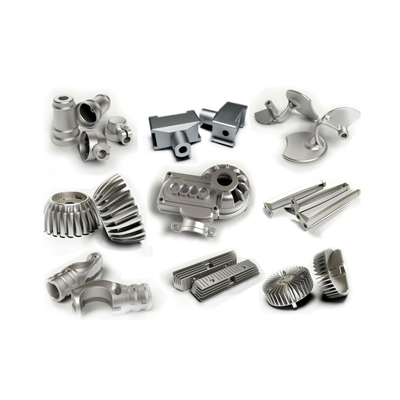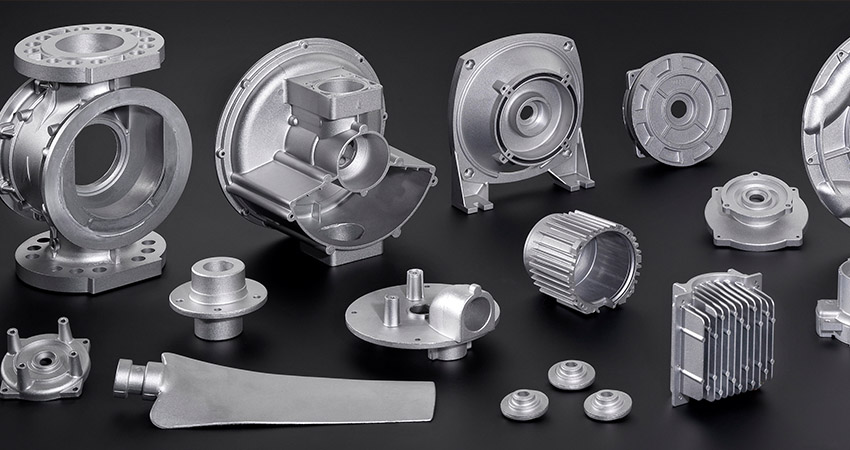How Aluminum Casting improves vehicle performance through lightweight components
A Comprehensive Guide to the Various Kinds and Applications of Aluminum Castings
Aluminum castings are vital components in different industries, recognized for their light-weight and resilient buildings. Various casting approaches, such as sand, pass away, and investment casting, offer distinct advantages customized to particular applications. Recognizing these processes is vital for picking the right method for a project. Each strategy has its distinct advantages, influencing layout and production options. The expedition of these techniques exposes a deeper understanding right into their effect on modern manufacturing.
Review of Aluminum Castings
Aluminum castings are essential components in numerous industries, recognized for their lightweight and corrosion-resistant residential or commercial properties. These castings are generated through procedures that allow for complex designs and high dimensional accuracy. The adaptability of aluminum makes it an ideal option for a series of applications, from automobile components to customer electronic devices. Because of its exceptional thermal and electric conductivity, aluminum is likewise preferred in electrical housings and warmth sinks. Additionally, aluminum castings can be treated with numerous surface area coatings, boosting their visual charm and longevity. The product's recyclability adds to its sustainability credentials, making it an eco-friendly choice. In addition, the availability of different aluminum alloys allows producers to tailor the mechanical residential properties to certain requirements, providing enhanced toughness or boosted resistance to wear. Generally, aluminum castings play a considerable duty in modern-day manufacturing, contributing to the performance and performance of various items throughout diverse markets.
Sand Casting: Refine and Applications
While different casting techniques exist, sand casting stays one of one of the most commonly used techniques because of its simpleness and versatility. This process entails developing a mold from a mixture of sand and a binding representative, permitting the manufacturing of intricate forms with high dimensional accuracy. The aluminum is melted and put right into the mold, where it takes the desired form as it cools down and strengthens.
Sand casting is particularly reliable for creating large parts and reduced to tool volume runs, making it suitable for numerous sectors, consisting of automobile, aerospace, and consumer items. Its convenience permits the casting of elaborate layouts, fitting diverse specs. Additionally, sand molds can be reused numerous times, enhancing cost-effectiveness. The simplicity of sourcing products and the fairly low arrangement expenses even more add to its extensive fostering. Generally, sand casting plays a critical function in the aluminum casting landscape, fostering technology and effectiveness.
Die Casting: Benefits and Uses
Die casting deals several advantages that make it a recommended method for generating aluminum elements in numerous industries. This process permits high-volume production with extraordinary dimensional precision and surface finish. The fast solidification of aluminum throughout die casting causes a strong and long lasting item, lessening the need for substantial machining or ending up processes.
Furthermore, pass away casting enables the production of complicated forms and complex layouts, which can be challenging to achieve with various other casting approaches. The efficient use of materials minimizes waste, making it an affordable option for suppliers.
Applications of die casting period various industries, consisting of auto, aerospace, and customer electronic devices, where light-weight and high-strength components are important. Generally, pass away casting attracts attention for its ability to deliver quality, effectiveness, and adaptability in aluminum part manufacturing, strengthening its function in contemporary production techniques.
Financial Investment Casting: Accuracy and Information
Investment casting is a precision production process that enables elaborate designs and thorough features in aluminum parts (Aluminum Casting). This technique provides many benefits, including high dimensional accuracy and a smooth surface coating. Its convenience makes it appropriate across numerous industries, from aerospace to clinical tools
Refine Overview
The financial investment casting process stands out for its capacity to produce elaborate aluminum elements with exceptional precision and information. This technique begins with creating a wax or polymer pattern that is a reproduction of the preferred component. Next off, the pattern is covered with a ceramic covering, which is after that warmed to harden. When the shell is set, the wax is disappeared, leaving a tooth cavity in the shell. Fluid aluminum is put into this dental caries, loading it to create the last part. After cooling, the ceramic covering is escaped, revealing the actors part. This procedure enables for complex geometries and great surface area finishes, making it suitable for different applications, from aerospace to automobile industries.
Benefits of Investment Casting
Among the primary advantages of investment casting depends on its ability to supply high-precision elements with detailed details. This approach enables the production of complex geometries that are frequently unattainable with various other casting strategies. Investment casting lessens the need for considerable machining, reducing product waste and manufacturing time. Additionally, it allows making use of various aluminum alloys, boosting the flexibility of the last product. The process is characterized by a smooth surface finish, which can bring about improved performance and aesthetic appeals. Moreover, investment casting is appropriate for both tiny and big manufacturing runs, suiting a vast array of sectors. In general, its precision and efficiency make investment casting a favored option for producing elements calling for precise requirements.
Applications in Industry
While various casting approaches offer certain objectives, investment casting stands out for its prevalent applications throughout several markets due to its unrivaled accuracy and detail. This strategy is particularly favored in aerospace and automotive fields, where complex elements require specific requirements for security and performance. Financial investment casting allows for the manufacturing of complex forms, such as wind turbine blades and engine parts, that typical techniques can not accomplish. Additionally, clinical device makers make use of investment casting for creating extremely detailed tools and implants, making certain biocompatibility and capability. The electrical and electronic devices markets also profit, creating components like housings and adapters that require fine read this resistances. Overall, financial investment casting's convenience and accuracy make it a vital procedure in modern production throughout diverse areas.
Comparison of Casting Techniques

Sand Casting Advantages
Sand casting offers numerous benefits over other casting methods, particularly when it pertains to convenience and cost-effectiveness. This technique enables the production of complex forms and huge components without the need for expensive tooling. Additionally, the sand used in this process is readily available and inexpensive, making it an attractive choice for both small and large manufacturing runs. The capacity to reuse sand advertises sustainability and lowers material prices. Moreover, sand casting accommodates a range of aluminum alloys, boosting its flexibility for various applications. The procedure is additionally relatively straightforward, which adds to shorter preparations and flexibility in manufacturing. These variables make sand casting a preferred selection for several markets seeking trusted and cost-effective services.
Die Casting Performance
Different casting methods are readily available, die casting stands out for its efficiency, specifically in high-volume production circumstances. This technique employs high-pressure pressures to infuse liquified aluminum into a mold and mildew, resulting in rapid cycle times and consistent item top quality. Compared to sand casting and financial investment casting, die casting substantially minimizes material waste and permits elaborate designs with limited tolerances. The capacity to produce huge quantities of parts promptly makes it excellent for industries such as auto and consumer products. In addition, pass away casting can facilitate making use of less costly alloys, even more enhancing its cost-effectiveness. On the whole, the effectiveness of die casting makes it a recommended option for suppliers aiming to maximize both production rate and quality.
Financial Investment Casting Accuracy
Investment casting is extensively recognized for its extraordinary accuracy in producing complicated forms and intricate details. This technique includes developing a wax pattern, which is covered in a ceramic shell, and subsequently dissolved, leaving an exact dental caries for liquified aluminum. Contrasted to various other casting approaches, such as sand casting or pass away casting, investment casting offers tighter tolerances and a smoother surface area coating. This accuracy makes it excellent for applications calling for high precision, such as aerospace and clinical tool parts. While the first arrangement costs may be higher, the long-term benefits include decreased machining needs and consistent top quality. Financial investment casting stands out as a recommended option for intricate styles and requiring specs in various industries.
Industry Applications of Aluminum Castings
Aluminum castings play a vital role throughout countless industries due to their light-weight, corrosion-resistant homes and exceptional strength-to-weight proportion. In the vehicle field, aluminum castings are thoroughly made use of for engine parts, transmission housings, and architectural components, adding to fuel efficiency and efficiency. The aerospace market take advantage of aluminum castings in aircraft frames, engine mounts, and interior fittings, where weight decrease is crucial.
In enhancement, the consumer electronics market uses aluminum castings for enclosures and elements, boosting toughness while keeping a smooth visual. In the construction market, aluminum castings are employed in building components, window frames, and architectural supports, offering strength versus weathering. The aquatic field favors aluminum castings you can look here for watercraft hulls and installations due to their resistance to saltwater rust. Overall, aluminum castings provide functional solutions, satisfying varied requirements across numerous applications while keeping high performance and dependability.

Future Fads in Aluminum Casting Innovation
As sectors remain to advance, developments in aluminum casting modern technology are poised to reshape making processes and item layout. Emerging patterns consist of the integration of automation and man-made intelligence, improving manufacturing and enhancing quality assurance. 3D printing is additionally acquiring traction, enabling for much more complicated geometries and decreased waste, consequently advertising sustainability. Additionally, the development of high-performance alloys is increasing the applications of aluminum castings, allowing markets to satisfy extensive performance standards.
Another substantial fad is the raising concentrate on recycling and the circular economic climate, with advancements intended at recycling aluminum scrap successfully. Market players are also buying clever production techniques, integrating IoT for real-time surveillance and anticipating upkeep. Improvements in surface therapy modern technologies are enhancing the longevity and aesthetic appeal of aluminum castings. Jointly, these fads symbolize a transformative duration in aluminum casting, driving performance, sustainability, and advancement throughout various sectors.
Frequently Asked Questions
What Are the Ecological Influences of Aluminum Casting Processes?
The environmental influences of aluminum casting processes include greenhouse gas discharges, energy consumption, and waste generation. These factors contribute to air and water contamination, triggering the need for lasting practices and boosted source administration in the industry.
How Can Aluminum Castings Be Recycled Efficiently?
Reliable recycling of aluminum castings entails gathering scrap, getting rid of pollutants, and melting the aluminum to create new castings. This process preserves energy, decreases waste, and decreases ecological effects, advertising a more sustainable production cycle.
What Is the Regular Life-span of Aluminum Castings?
The normal lifespan of aluminum castings differs significantly, often long-term in between 20 to 50 years depending upon environmental aspects, alloy composition, and application. Their resilience makes them appropriate for numerous requiring commercial and architectural uses.
Are There Any Type Of Health Dangers Connected With Aluminum Casting?
Concerns relating to wellness threats connected with aluminum casting consist of potential direct exposure to fumes and dirt. Long term inhalation may lead to breathing problems, while skin get in touch with can trigger inflammation. Correct safety and security procedures are important to mitigate these threats.
How Do Aluminum Castings Contrast to Other Materials in Toughness?
Aluminum castings show a favorable strength-to-weight proportion contrasted to lots of materials, including steel straight from the source and plastics (Aluminum Casting). They are light-weight yet solid, making them ideal for applications requiring sturdiness without too much weight, such as auto and aerospace components